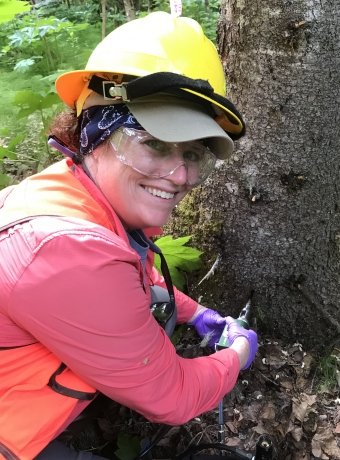Elizabeth Graham

- MS Forest Ecology and Management 2004
After growing up in Chicago and attending the University of Illinois for her undergraduate studies, Elizabeth “Liz” Graham can still remember the first time she saw a Keweenaw autumn and the way the trees shifted from green to gold and red. Liz graduated from Michigan Tech in 2004 with a Master of Forest Ecology and Management degree.
Liz was one of Andrew Storer’s first graduate students, and under his tutelage she studied chemical communication in bark beetles. She returned to the University of Illinois for her PhD in entomology, and then went on to Michigan State for a post-doc, studying insect chemical communication and the emerald ash borer with the US Forest Service in East Lansing. Liz moved to Alaska seven years ago.
“I felt like I won the lottery when I got the job in Alaska,” she says. “I love it here. I live one mile from a glacier, a mile from the ocean, and the mountains are in 360.”
In her role as entomologist for the US Forest Service Forest Health Protection team at the Juneau Forestry Sciences Laboratory, Liz studies forest health issues related to insects to aid with forest management planning. And while she definitely does not welcome a bark beetle outbreak, her love of insects fills her with a sense of wonder in her daily work.
“Bark beetles can be fascinating; something as small as a tic-tac can take out huge trees,” she says. “Sometimes I feel like I’m advocating for the beetles. It’s devastating to find giant stands of dead trees, but it’s sort of amazing to look at what a small beetle can do, millions and millions of them.”
Liz is currently studying a spruce beetle outbreak in south-central Alaska where more than a million acres of trees are beetle-killed.
“One of the things we do here is aerial detection surveys,” she says. “We fly in small float planes at low altitude to map the damage. Seeing an outbreak from the air, and how extensive it is, is remarkable. I am lucky; some of the fieldwork I get to do is amazing.”
During a hemlock sawfly outbreak—a pest native to Alaska that causes defoliation—Liz flew to Admiralty Island and was picked up by a boat operator for the next leg of the journey to her fieldwork site. The boat operator asked whether she was there to do whale watching, and when she mentioned she wasn’t, he grinned and informed her otherwise.
“Well, I see 16 humpbacks bubble-net feeding between here and where we need to go, so we are going to do some whale watching today,” the boat operator said.
Liz joked that moving to Alaska, with its 907 area code, was a natural next step from the Upper Peninsula—area code 906.
“There are a lot of similarities between the UP and Alaska,” she says. “The mentalities are the same. Recreating outdoors and enjoying that lifestyle.”
From the Winter 2020 edition of the Forestry Newsletter.